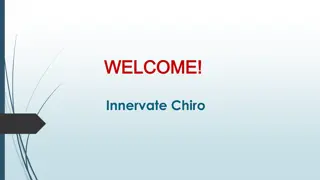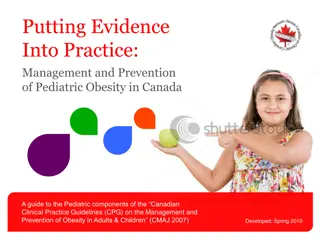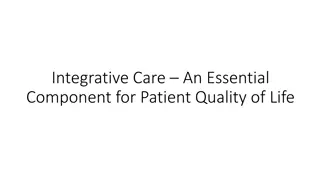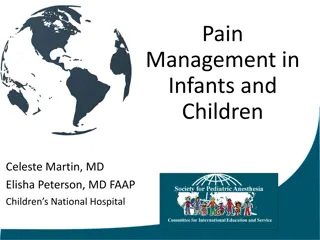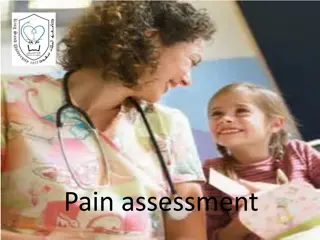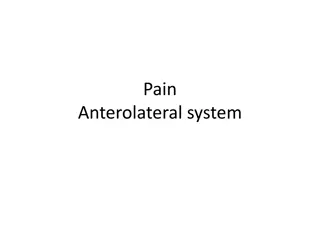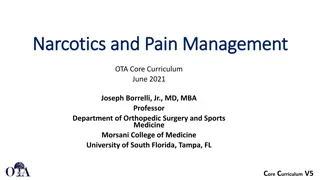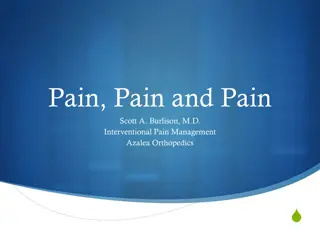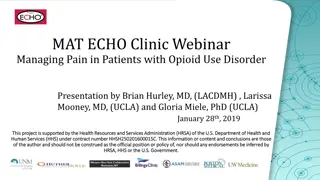Integrative Approaches to Pediatric Pain Management: A Comprehensive Review
Pediatric pain management is a complex issue involving factors such as inflammation, neuroplasticity, and emotional responses. Dr. Matthew Hand explores integrative approaches to address common pediatric pain conditions and highlights the prevalence of chronic pain in children. The presentation delves into the epidemiology of pediatric pain, focusing on headaches, abdominal pain, and musculoskeletal/back pain. Additionally, it discusses the importance of mindful practices in creating a positive experience for children dealing with pain.
- Pediatric Pain Management
- Integrative Approaches
- Chronic Pain Epidemiology
- Mindful Practices
- Pediatric Pain Issues
Download Presentation

Please find below an Image/Link to download the presentation.
The content on the website is provided AS IS for your information and personal use only. It may not be sold, licensed, or shared on other websites without obtaining consent from the author. Download presentation by click this link. If you encounter any issues during the download, it is possible that the publisher has removed the file from their server.
E N D
Presentation Transcript
Integrative Approaches to Pediatric Pain Matthew Hand DO Section Chief, Pediatric Nephrology and Integrative Medicine. Children s Hospital at Dartmouth/Dartmouth Health Children s Clinical Assistant Professor, Geisel/Dartmouth Medical School
Goal What is IM? How can it be practically applied? Management of common pediatric pain issues. How to create a mindful day for kids.
Pain in pediatric What pain is can be hard to completely define. I break it down to 3 primary issues Inflammation Upregulated sympathetic response Neuroplasticity Studies have shown increased pain perception in patients with depression Anxiety associated with decreased pain threshold. Dysregulation of the nervous system with pain even without overt cause. Changes in the brain shown with chronic pain sensation including emotional centers of the brain.
Review of Chronic pain epidemiology 40 % of children experience pain at least weekly 20-35 % of children experience chronic pain Most common Headache Abdominal pain Musculoskeletal/Back pain Pain 2011 MacDonald et al
Pain in children in Germany 83% had experienced pain over 3 months (35% pain more than once a week) 31 % for more than 6 months Headache 60 % Abdominal pain 43% Musculoskeletal pain 34% Associated with sleep issues/eating problems/school absence/social issues Pediatrics 2005 Schmucker et al
Who is looking for integrative care? Integrative Clinic: three biggest diagnosis Headache Abdominal pain Musculoskeletal pain Pain 6-7/10 Multiple co-morbidities: fatigue/anxiety/stool changes/sleep issues 71% on prescription meds J Altern Comp Med 2013 Kemper
Acute pain: <3 months of duration Chronic pain: > 3months or beyond the expected duration of healing leading to pain, emotional distress and functional disability cycle Pediatric pain compounded by parental concerns and perceptions
Three very important questions: Can you imagine yourself without the pain? How would your life be different if it was gone? Are you ready to be well? Always ask about sleep. When they fall asleep do they stay asleep? Why? if pain is there-how do we down regulate the system or change the perception.
Short and Long term concepts Decrease inflammation Improve upregulated state Change the neuroplasticity The latter takes the longest Commonly not noticed for a number of months by the patient Commonly parents will see improvement in the first month by parents but when ask the child they will say it is the same
What is IM Broad Categories Conventional Med Nutrition/Diet Exercise/Physical Activity Whole systems (TCM, Ayurveda, Naturopathy, Homeopathy) Botanical med Energy Medicine (Reiki, Healing touch, Qi Gong etc) Supplements Spirituality Manual Medicine (OMM, Chiropractic, Massage, PT, Zero balancing, reflexology etc) Mind-Body Medicine (Hypnosis, Biofeedback, Guided imagery, Creative therapy etc)
Functional Abdominal Pain Therapy Recurrent Abdominal Pain: -Address Diagnosis -Address Pathophysiology -Work-up if red flags present -Normalize lifestyle -Fiber therapy, bulking agents -Medications: anti-spasmodics, H2RA, PPI, anti-emetics, motility, bacterial overgrowth From Mark Integlia MD, Dir. Peds GI NHHC
Complementary and Alternative Therapy Use of Different CAM Therapies CAM Therapy Patients (N=278); n (%) Phytotherapy Supplements Manual therapies Homeopathy Energy Medicine Traditional Chinese Medicine Bioelectrical therapies Others (mind-body, philosophical, rest group) 128 (46) 100 (36) 66 (24) 61 (22) 48 (17) 30 (11) 22 (8) 35 (13) Vlieger et al. Pediatrics. 2008;122; e446-e451. From Mark Integlia MD, Dir. Peds GI NHHC
Complementary and Alternative Therapy Mind-Body Therapy: *Cognitive Behavioral Therapy (CBT) *Gut-directed Hypnotherapy (HT) *Biofeedback *Guided Imagery Botanicals: *Peppermint Oil *Ginger Biologics: *Probiotics Acupuncture Yoga From Mark Integlia MD, Dir. Peds GI NHHC
Complementary and Alternative Therapy CBT: Children and caregivers are taught: -reframe perception of pain -reward well behavior -establish contingency plans for management of pain -attempt to ignore pain behavior -use of positive self-talk, relaxation and imagination -56% pain-free initial response with 75% pain-free at 6 months Sanders et al: J Consult Clin Psychol. 1994;62:306-314. -Groups taught CBT: 72% pain-free post intervention Humphreys et al: J Pediatr Gastroenterol Nutr. 2000;31:47-51. -25% decrease in pain scores and 30% decrease in absenteeism Robins et al: J Pediatr Psychol. 2005;30:397-408. From Mark Integlia MD, Dir. Peds GI NHHC
Complementary and Alternative Therapy Hypnotherapy: Many similar characteristics to CBT -An explanation of the physiology of pain -An emphasis on non-pain behavior -Relaxation and mental imagery -Major difference: specific suggestions for relief of pain via therapist RCT: comparing effectiveness of HT vs. standard medical therapy (SMT) -53 patients; age 8-18 years with FAP (n=31) or IBS (n=22) -HT: 6 session over 3 months -SMT: standard medical care and 6 sessions supportive care -pain intensity, frequency and associated symptoms were scored post therapy, 6 mo and 12 mo. Vlieger et al. Gastroenterology. 2007;133:1430-1436.
Complementary and Alternative Therapy SMT HT SMT HT SMT HT post 6mo 12mo Improved 32% 26% 17% 22% 29% 11% Remission 12% 59% 17% 71% 25% 85% P< .001 between treatment groups at all end points Vlieger et al. Gastroenterology. 2007;133:1430-1436. From Mark Integlia MD, Dir. Peds GI NHHC
Complementary and Alternative Therapy Biofeedback: -Combines relaxation and mental imagery with visual or auditory feedback of somatic changes -ie: skin temperature, skin resistance, heart rate variability -Especially helpful in modulating autonomic reactivity Guided Imagery: -A form of self regulation in which a state of deep relaxation in induced using progressive muscle relaxation (PMR) -The subject is then guided to actively create images to facilitate resolution of the problem - Differs from hypnosis in that the patient creates their own solution - Especially effective in children due to their ability to have active, creative imaginations From Mark Integlia MD, Dir. Peds GI NHHC
Complementary and Alternative Therapy Peppermint oil: Carminative- gas relieving Menthol- component which acts to relax smooth muscle by blocking calcium channels; most products have 44% menthol Also found to have mild topical anesthetic effect In children found to be both safe and effective. Dose: 0.2-0.4 ml per day Forms: enteric coated, peppermint oil soft gels, oil Randomized, double-blind, controlled 2-week trial: 50 children; dose- 1-2, 187mg peppermint oil 3X/day for 2 weeks 76% receiving enteric coated peppermint oil caps with decrease Sx 19% decrease in placebo group Kline et al. J Pediatr 2001;138:125-8. From Mark Integlia MD, Dir. Peds GI NHHC
Complementary and Alternative Therapy Probiotics: Ecosystem of gut may differ at times of illness and health supportive effect of inflammation with probiotics Barrier effect with alteration of mucus layer Treatment- may support symptoms of traveler s diarrhea and viral gastroenteritis Lactobacillus and Bifidobacterium studied most often Forms- powder, yogurt, capsules, chewable tablets, freeze-dried powders, wafers and beverages. From Mark Integlia MD, Dir. Peds GI NHHC
Complementary and Alternative Therapy Probiotics: Lactobacillus rhamonosus GG (LGG) Randomized, double-blind,, placebo-controlled trial receiving either LGG or placebo for 8 weeks; 141children Outcome: overall pain at end of intervention period LGG- significant reduction of frequency and severity of abd pain p<.02 and .001 respectively Week 12: treatment success: 48 children LGG vs. 37 placebo p<.03 Francavilla et al. Pediatrics. 2010;126:e1445-e1452. From Mark Integlia MD, Dir. Peds GI NHHC
Colic Two good reviews Rosen et al Pedi in review 2009 Rosen : Explore July 2007 Fennel seed oil 125 colicky babies, placebo controlled 65% improvement in treatment group vs 24% control Botanical blends Fennel, chamomile, vervain, licorice, lemon balm Large volume (3 oz/day) 57% improved crying vs placebo 26% Fennel, chamomile, lemon balm, rosemarinic acid, b vit Crying decreased by 85% in treatment group, stat sig vs placebo 200->76 min per day
Probiotics 2009 L. Reuteri 100 mill CFUS Compared to simethecone Improvement in one week, increased over 4 weeks, 200min/d- >159->51min/d 95% response vs 7% in simethecone group 2010 repeated with placebo only Again stat significant in probiotic group
Manual medicine Infant massage Multiple studies showing benefit in infant irritability and bonding Chiropractic 3 studies that I have seen reviewed 2 positive, one not no cracking! OMM Small study without control, improvement
Cautions Fennel is sometimes mixed or confused with Star Anise. Chinese anise is viewed as safe, Japanese is not-> neuro toxic. Thus good products are important
Headaches ~ 10% of population with migraines Women 3X more frequent 112 million bed ridden days $13 billion cost to employers in US Hu et al Arch Int Med 1999 2-3 X greater school loss days in children with HA
Continued 2007 study (Diamond et al Headache) 120,000 households contacted 17.9 % females, 5% males w/ migraine criteria ~ 60% never diagnosed Only 12% using any preventive measures
Migraine Chronic daily HA 2-7 % of all children diagnosed with CDH More evidence this may be related to medication overuse. Thus: high priority/emphasis on prevention/triggers IE: stress reduction, sleep, exercise, eating habits Adjunctive nondrug therapies and lifestyle changes round out the requirements for a management plan. The chances for long-term remission or significant improvement are up to 65% Couch JR Curr Treatment Options Neur 2011
Triggers ~60% stress 54% sleep issues 39% missed meals Diet (caffeine-withdrawal, food additives etc.) Rothrock et al Headache 2010 Back and neck pain Dehydration Me for 10 years
Acupuncture The best summation Consistent evidence that acupuncture provides additional benefit for treatment of acute migraines. Acupuncture is at least as effective as, or possibly more effective than, prophylactic drug treatment and has fewer side effects. Acupuncture should be considered a treatment option for patients willing to undergo this treatment Linde et al Cochrane Database Systemic Review 2009
Mind Body Therapies Guided imagery, biofeedback, CBT, Hypnosis and can consider certain herbs (anxiolytics/adaptogens) With stress being highest cause of migraine triggers, it would seem to make sense. Be mindful of patients religious and spiritual beliefs. Be aware of prior events that could have a PTSD effect
Continued Quite a few studies on various techniques Children very good with this given imagination Best summary: Behavioral treatments possess the most evidence for successful headache management. They have a long history of randomized trials showing efficacy and are considered the first line preventive options. Nicholson et al Curr Treatment Options Neuro 2011
Supplements/Botanical Magnesium: early studies showed low mag in migraine sufferers For Prevention: 2 studies (RDBPCT) show effective For children, data on tension type headaches Sun-Edelstein 2009 Grazzi et al Neurol Sci 2007 This had a 70% decrease in HA, 65% decrease in analgesia use and 75% improvement in lessening disability-not controlled
Riboflavin (B2)/CoQ10 Riboflavin >50% reduction in migraine headaches Dose: 400 mg a day, biggest tablet is only 100 mg CoQ10 (Ubiquinone) 50% reduction in migraine events (adults 100mg tid) Pediatric study-1-3 mg/kg/day markedly decreased HA and disabilities Need gel or liquid, can be expensive
Butterbur Quite good evidence, recently recommended by Amer Acad Neurology 2012 2 RDBPCT (Grossmann et al 2000, Lipton et al Neurology 2004 Open trial in children showing decreased frequency of HA. PA free Commonly studied one is Petadolex 75 mg bid
Feverfew 5 RCT, 3 with some benefit Interestingly herbalists report that only fresh plant works which may be part of the problem. Fresh plant can have mouth sores Can have withdrawal, IE rebound HA I have changed my practice
Ginkgo New product on the European Market Ginkgo, CoQ10 and Riboflavin. 3 trials good results (second two in kids) D Andrea et al Neurol Sci 2009 Esposito et al Neurol Sci 2011 Usai et al Neurol Sci 2010 Hard to know exactly effective agent but the latter 2 components are low dose.
Yoga John, PJ et al Headache 2007 72 patients, randomized to yoga or self care Stat sig decrease in headache intensity, frequency, pain rating index, anxiety and depression scores, medication use Small study from India showed TTH patients with greater decrease in temporalis muscle EMG activity compared to NSAIDS and botulism toxin. Multiple studies show stress reduction, anxiety and mood issues in adults. I like this for stress reduction, alignment, breathwork and regaining control of ones life
Manual therapies Osteopathic manipulation, Massage, chiropractic, PT Small studies but positive results Ex Voigt et al J Alt and Comp Med 2011 Interestingly in JAOA OMM vs no OMM, chart reviewed study 50% reduction in cost in patient treatments Mostly meds To me, it is critical, healing touch and trying to remove a primary trigger One of the reasons I went back to active manipulation.
References/Resources 1) Zeidan and Vago, Mindfulness mediation-based pain relief: a mechanistic account, Ann NY Acad Sci. 2016 June 2) Eccleston C et al, Psychological Therapies for the Management of chronic and recurrent pain in children and adolescents, Cochrane Database of Systemic Reviews 2014 3) Ali A et al, Mindfulness-Based Stress Reduction for Adolescents with Functional Somatic Syndrome: A Pilot Cohort Study, J Peds 2017 April. 4) Waelde L et al, A Pilot Study of Mindfulness Meditation for Pediatric Chronic Pain, Children 2017 April. 5) Kabat-Zinn, J.; Lipworth, L.; Burney, R. The clinical use of mindfulness meditation for the self-regulation of chronic pain. J. Behav. Med. 1985, 8, 163 190. 6) Kabat-Zinn J, An Outpatient program in behavioral medicine for chronic pain patients based on the practice of mindfulness meditation: theoretical considerations and preliminary results, Gen Hosp Psychiatry. 1982 April. 7) Chadi N et al, Mindfulness-based intervention for femal adolescents with chronic pain: A pilot randomized trial, J Can Acad Child Adolesc Psychiatry, 25:3 2016 8) Headspace Mindfulness documentary series, Netflix 9) This is Me, song, The Greatest Showman 10) Self Hypnosis balloon technique, University of Wisconsin Integrative Medicine website.






